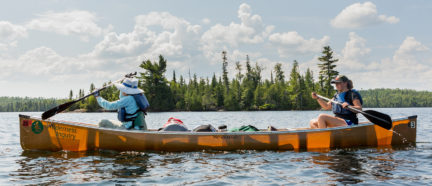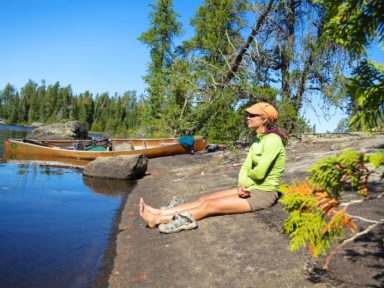There are many charts that display where humans feel certain emotions. Broadly, it can be agreed upon that anger is felt most prominently within a person’s head, while sadness sits in the chest and anxiety in the stomach. But where, within our complex anatomy, do we feel the emotion of awareness? Perhaps within the diaphragm, where the act of mindful breathing is pursued. Or potentially it is within the mind itself, where an individual feels a physical sense of consciousness. But perhaps the best explanation is stated by the late Sigurd Olson, who based the feeling of awareness on his explorations of the Boundary Waters. As quoted from his book, Reflections from the North Country:
“Our senses are synchronized to the great quiet by millions of years, making it possible to hear things that  today are forgotten. So responsive can we become, even the slightest movement of grasses, leaves, or insects is part of our awareness, until it seems we are hearing with our skin, our sight, smell, and touch, for these are part of the overall pervading silences of the past.”
today are forgotten. So responsive can we become, even the slightest movement of grasses, leaves, or insects is part of our awareness, until it seems we are hearing with our skin, our sight, smell, and touch, for these are part of the overall pervading silences of the past.”
Olson helps his readers become aware of the sensations that can be felt while in the outdoors, and perhaps this is especially true for readers who are familiar with the Boundary Waters. The Boundary Waters Canoe Area Wilderness (BWCAW) is a wildlife reserve that encloses over a million acres of pristine land along the northeastern border of Minnesota and a small southern portion of Canada. It is about thirty miles to the closest U.S. town (Ely, MN) and is one of the most visited wildernesses in the nation. While it may appear to be like any other wilderness area, the BWCAW presents a sense of liberation to its travelers. Only a limited amount of people are able to be within the wilderness within any given time, which makes the land uncrowded. Moreover, only non-motorized vehicles are allowed within the BWCAW, which means that the noise pollution is minimal compared to other wildlife reserves.
 What makes the BWCAW so exciting is how it is pristine and virtually untouched by man. A person can canoe for miles without seeing another soul, and the company they bring is typically the company they have for the entire trip—that is, besides the animals this traveler is bound to encounter. Bears, lynx, otters, and a myriad of other creatures make their homes here in this wilderness. It is more likely for people to encounter uncommon animals (such as moose and wolves) because they are given more space to exist compared to a crowded and human-controlled wildlife reserve.
What makes the BWCAW so exciting is how it is pristine and virtually untouched by man. A person can canoe for miles without seeing another soul, and the company they bring is typically the company they have for the entire trip—that is, besides the animals this traveler is bound to encounter. Bears, lynx, otters, and a myriad of other creatures make their homes here in this wilderness. It is more likely for people to encounter uncommon animals (such as moose and wolves) because they are given more space to exist compared to a crowded and human-controlled wildlife reserve.
To feel entirely aware of a place is a gift that many people are losing in modern times. Our bodies have adapted to the intense focus of everyday life, meaning that we are accustomed to dismissing stimuli that is deemed as unnecessary. Instead we concentrate on what is immediately important—such as work, school, or family-life. This is not a bad adaptation, but too much of this behavior can result in anxiety and sadness. Yet, places like the BWCAW offer explorers the opportunity to separate themselves from the buzz of their everyday environment. Spaces such as this provide the eager adventurer an opportunity to see the north country in its purest form.
Olson could have been inspired by many instances to write about the topic of awareness. Maybe he was reeling a walleye into his canoe, or spotted a moose and her calves step calmly through a shallow marsh. Perhaps he breathed in the sharp scent of pine needles and moss, or heard a loon’s harrowing call echo over a lake. Regardless of his intentions to write about this, it is time for you, the reader, to find your sense of aliveness in the Boundary Waters and experience the “great quiet” for yourself.
-Megan Rod


Leave a Reply